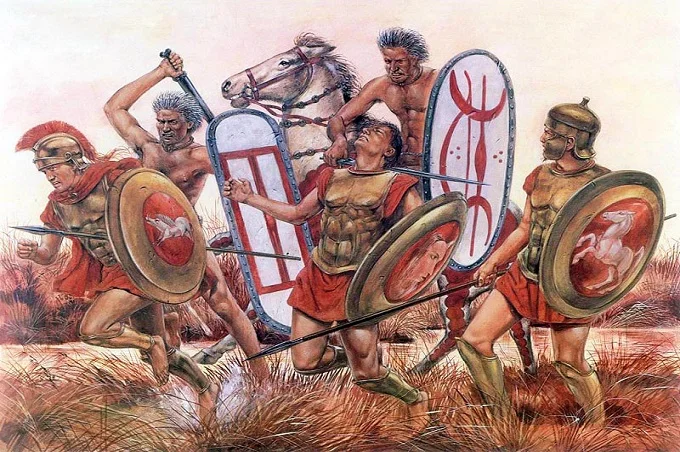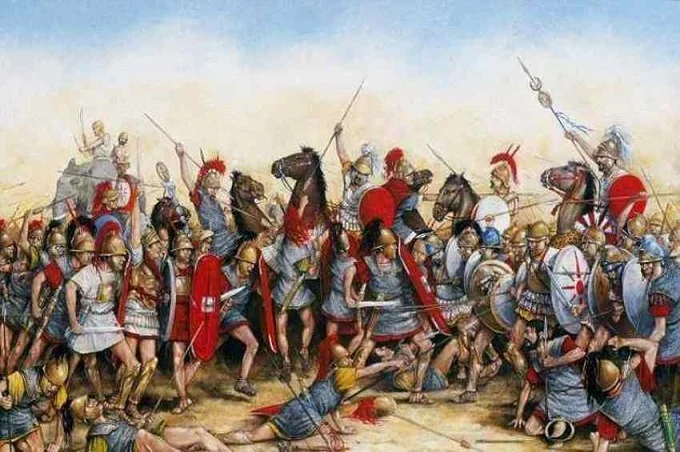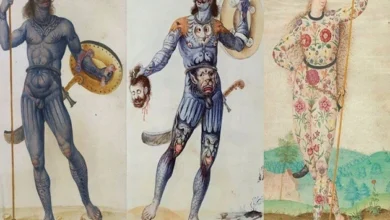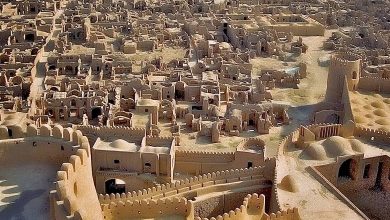10 biggest military defeats of Rome

We used to imagine Rome as an unbeatable military machine that destroyed everything in its path and easily conquered peoples of all socioeconomic levels. However, Rome was far from unbeatable. It was occasionally possible to take advantage of the “savages,” to the point where practically the whole population had to be quickly organized to prevent the country from being lost to the enemy.
Many defeats have happened during Rome’s history, some of which were epic in scale. You will reconsider the Roman army’s invincibility after reading this article.
10 biggest military defeats of Rome
1. Battle of Allia (387 century BC)

The first invasion of the Gauls into the Roman Republic took place. It all started with the fact that the Celts from modern Northern Italy first brought the Etruscan city of Clusium to their knees. Then, trying to escape from a not particularly desirable fate, he turned to the Roman Republic for help. And here the myth collapses again, this time about the impeccable diplomatic skills of the Romans. First, peace negotiations failed, so much so that one of the Roman delegates killed the Gallic leader. Then the tribe retreated and, contrary to the expectations of the Romans from some kind of “barbarians”, sent their delegates to Rome so that the council would hand over the murderer brothers to them. But there again, everything went wrong, and then the Gauls decided to take the next step, namely, to leave Clusium and go to Rome.
The Republicans did not expect this and sent an army to defend the capital, according to various estimates, from 15 to 40 thousand soldiers. The Gauls, on the other hand, had an army of 12 to 70 thousand people. Around 390 or 387 BC, a battle took place, known as the Battle of the Allia, a small river that flows into the Tiber near Rome. Describing these events, ancient historians mention the underestimation of the Gauls by the Romans. Not only did they not fortify their camp, but they stretched out the army as if it were a march to the tavern and not the defence of the capital. To get the latest stories, install our app here
Historians write that the Gauls moved in a swift wave through the scattered troops of the Romans and demolished them like a stream of a stormy river, turning most of the soldiers to flight. Titus Livy said that the Roman soldiers did not die in battle but trampled each other, and the Gallic massacre completed everything. The Roman losses were catastrophic.
But this was not enough for the Gauls. They marched on Rome, plundered and destroyed it. However, most of the city’s population managed to escape the night before to avoid serious civilian casualties. The remaining residents barricaded themselves in the Capitoline Hill, and the Gauls began to lay siege to it, which they held for 7 months. It was here that the legend about the holy geese arose, which woke up the guards, notifying them of the Gauls warriors storming the Capitol.
Having learned that the Veneti could invade the lands of the Gauls, they lifted the siege and entered into negotiations. The Romans agreed to a large ransom, and the Gauls retreated. Since then, July 18, the day when the Battle of Allia took place, was considered a day of mourning by the Romans.
2. Battle of the Caudine Forks (321 BC)
The battle of the Caudine Forks (321 BC) was a devastating loss inflicted on the Romans in the Apennine Mountains by a Samnite force (Second Samnite War).
In 321 BCE, the Roman consuls Veturius Calvinus and Postumius Albinus resolved to conquer Samnium, but they prepared badly and chose the incorrect path. The route wound through a small pass between Caudium and Calatia, where Samnite leader Gavius Pontius cornered the Romans and forced them to surrender. To get the latest stories, install our app here
Each man in the Roman army was subjected to a humiliating ceremony, forcing them to “pass under the yoke,” during which they were stripped naked and forced to pass under a yoke made of spears. Even though few people were killed, it was a great and prominent tragedy that resulted in a humiliating defeat and peace treaty.
3. Battle of Drepana (249 BC)

The First Punic War between Rome and Carthage began in 264 BC and did not go smoothly for the people of Italy. However, later Rome rallied and managed to repulse Carthage at sea, where the latter was previously considered an invincible enemy. In part, these victories were made possible by the invention of the Corvus, a kind of superweapon of the ancient world. But unfortunately, these victories were the cause of the sad events that followed them.
The fact is that, filled with pride for past victories, having no serious trump cards in his hands, the Roman consul Publius Claudius Pulcher at the military council proposed attacking the city of Drepana from the sea. Before each battle, the Romans performed fortune-telling, and this time the sacred chickens did not peck at the grain, which indicated a bad outcome. However, Pulcher being not a particularly religious person, threw the chickens overboard, saying: “If they don’t want to eat, then let them drink!”
The ships moved to Drepana and sailed to him at dawn. As expected by the Romans, the effect of surprise worked, and at first, the Carthaginians had a hard time. However, the Carthaginian commander Adherbal quickly assembled a fleet and led it into battle with the Romans. The Romans had at least 123 ships, while the fleet of Carthage consisted of 100 to 130 ships. But, having the advantage of surprise, the Romans could not realize it.
Moreover, the Carthaginian ships that left the harbor, more manoeuvrable than the Roman ones, launched a lightning attack. As a result, the Roman fleet was completely defeated, and out of 120 ships, only 27 survived, those that were in the rearguard with Pulcher and returned with their commander when the smell of fried. The number of human casualties was enormous – 20 thousand killed and taken prisoner.
As a result, Pulcher was accused of treason and sacrilege due to the chicken incident; however, he managed to avoid the death sentence and was exiled. As for the fleet, Rome recovered only seven years after the Battle of Drepana.
4. Battle of the Trebia ( 218 BC)
The Romans had a tradition of first losing and practically surrendering the country to the enemy and then straining, getting out of the crisis, and defeating the enemy. So it was in the Second Punic War. In the autumn of 218 BC, under the command of the famous commander Hannibal, the Carthaginian army decided on a manoeuvre that the Romans did not even think about, crossing the Alps from Spain to Italy. The transition was not easy for Hannibal, and he lost a lot of soldiers, but along the way, his army was replenished with Gauls and other peoples whose countries were occupied by Rome.
When Hannibal descended from the mountains, the Romans realized that they would soon have to pack their things and quickly flee the capital at such a pace. Then the consul Publius Cornelius Scipio volunteered to defend his homeland and decided to stop Hannibal at the Ticino River. But he failed, and he, along with the army, retreated to the Trebbia River. The consul Tiberius Sempronius Longus with several legions was already sent to his aid to Scipio by the Republic. To get the latest stories, install our app here
Together with the arrived legions under the command of Scipio and Long, there were about 45 thousand people. Hannibal had only 31 thousand soldiers. However, Hannibal was more cunning than the Roman commanders with fewer troops. He provoked Longus to att ack, after which he organized a simulated flight and lured the armies of the Roman consul to his main forces. The tired and hungry warriors of the Roman Republic, alerted by Longus, could not resist Hannibal’s well-fed and prepared troops.
The Roman troops were surrounded, and panic began. Finally, about 10 thousand Romans retreated to Placentia, and the rest were killed or captured. Carthage lost about 5 thousand people in this battle, mostly the Gauls who joined Hannibal. The Romans lost about 20 thousand people. As a result, Rome lost not only in the military but also in the geopolitical sense. After the Battle of Trebia, most Cisalpine Gaul rebelled, and Hannibal occupied all of Northern Italy without a fight.
5. Battle of Lake Trasimene (217 BC)

The Battle of Lake Trasimene is regarded as one of the biggest ambushes in history since it was the second in a series of important Carthaginian wins against the Romans. Hannibal marched his army south, directly into the heart of the Italian Peninsula, after the battle at the Trebia River a year before. General Gaius Flaminius, who assumed the enemy would march to Rome, was hard on their tail. However, the Carthaginians started to move east, reaching Perugia today. Hannibal developed a clever strategy for the shores of Lake Trasimene, knowing the Romans were on their heels. This valley, sandwiched between the water’s edge and a hill, was ideal for an attack. To get the latest stories, install our app here
The Carthaginian General timed his passage of this small trail perfectly to enable the Romans to see them when darkness fell on the opposite side of the valley. Gaius Flaminius marched his soldiers across the mist-covered valley the next morning to fight the Carthaginians on the opposite side. However, as the last of the men approached the bridge, tens of thousands of Gauls, as well as Carthaginian cavalry, charged down the hill. Many Romans perished in the lake while trapped in the middle, attempting to flee the attack. Only around 10,000 of the original Roman army of 30,000 made it out alive in the thick fog. The conflict also claimed the life of General Gaius Flaminius, whose corpse was never found. Only roughly 2,500 Carthaginians died.
6. Battle of Cannae (216 BC)
Another of the Second Punic War episodes became one of the most devastating battles in history for the Romans. This battle took place in southeastern Italy on August 2, 216 BC, near the city of Cannae.
As in many defeats, the Romans were let down by their pride. The fact is that Rome was able to gather an army consisting of more than 80 thousand people. The army of Hannibal at the same time was about 50 thousand soldiers. Feeling invincible with such a numerical superiority, the consuls Lucius Aemilius Paul and Gaius Terentius Varro believed that the battle would not last too long, and victory was already in their hands.
The troops met on the Aufidus River, near the city of Cannae. Having defeated a small detachment of the enemy, the Romans were even more inspired. According to all the strategies that existed, Hannibal had practically no chance of winning due to the small room for manoeuvre and the lack of escape routes. However, in his losing position, Hannibal was still a cunning commander and used the area to set up ambushes.
The strategy of Paul and Varro was simple: concentrate the main forces in the centre and crush the enemy with a numerical advantage. But when the battle began, Hannibal’s troops began to retreat, forcing the Romans to go deeper into the front. Then, when the legions of Rome had gone deep enough, the warriors who had been sitting in ambush along the flanks entered the battle and surrounded the troops of the Republic. After that, the numerical advantage of the Romans turned into a disadvantage because a huge number of soldiers were squeezed into a narrow ring and could not fight effectively.
Then the massacre began, from which about 14 thousand soldiers managed to escape. Polybius estimates that 70,000 Roman soldiers were killed. Titus Livy and Plutarch estimate the number of those killed at 48-50 thousand people and add another 10-15 thousand prisoners to the victims. As for the losses of Hannibal, they ranged from 5.7 to 8 thousand killed and up to 10 thousand wounded. As a result, Hannibal was able to destroy the best troops of Rome and demoralize the remaining enemy army. It is believed that then about 20% of the entire army of the Roman Republic was destroyed, 28 of the 40 tribunes of Rome and 80 senators died.
7. Battle of Noreia (112 BC)

Two Proto-Germanic tribes, the Cimbri, and the Teutons chose to abandon their homeland in what is now Denmark and relocate en masse to the south for reasons unknown to history. They met the Taurisci in present-day Slovenia around 113 BC. The Taurisci were Roman allies who sought their assistance in coping with the overwhelming threat. Consul Gnaeus Papirius Carbo handled the problem. In front of the Cimbri and Teutons, he appeared ahead of 30,000 warriors and made a show of power. The two tribes accepted Carbo’s request to flee after hearing stories of Rome’s military prowess. He even offered to take them to the border with multiple guides.
Gnaeus Carbo, however, being a politically ambitious man, was not satisfied with a mere diplomatic ending; he desired a military triumph. He told the escorts to bring the tribe members to Noreia, which is now in Austria, where he planned to ambush them. The Cimbri somehow learned about the scheme while traveling and surprised the Romans instead. Approximately 6,000 Legionnaires were able to flee, due in large part to a sudden rainstorm that aided their disappearance into the woods. One of them was Carbo. In humiliation, he went to Rome, where he was impeached as consul and later killed himself. The battle’s conclusion exposed the Roman territory to the victorious barbarians, who chose to go west into Gaul.
8. Battle of Arausio (105 BC)
What is described above cannot be compared with the defeat of the Romans at the Battle of Arausion in 105 BC. For a long time, the Roman Republic was bothered by raids from the Cimbri, Teutons, and other Germanic tribes. In those days, on the territory of modern southern France, there were already detachments of Rome, who constantly suppressed uprisings. But knowing that the Germans had a significant advantage in the soldiers, the Romans sent an expeditionary army, consisting of two corps, under the command of the proconsul Quintus Servilius Caepio and the consul Gnaeus Mallius Maximus, to help. As a result, there was an army in the region consisting of 80 thousand people.
The problem was that the corps of the expeditionary army stood in separate camps on the opposite banks of the Rhone between the cities of Arauzio since Caepio did not want to obey the senior Maximus because he had no real military experience and was not noble by birth.
When the Germans arrived at the Roman camps for peace negotiations about lands where they could settle, they did not know that the commanders were divided and first went to Maximus. After that, the ambassadors went to Caepio, but he was offended that the Germans did not turn to him in the first place, and treated the envoys rudely, for which the tribes decided to take revenge. They attacked Caepion’s camp and completely defeated his army. To get the latest stories, install our app here
Then the Germans attacked Maximus’s camp, also quickly defeating his army. It is believed that 80,000 Roman soldiers and another 40,000 auxiliaries and civilians died in this battle.
Subsequently, Caepio paid with his position in society, property, and citizenship for his carelessness and was exiled to Asia Minor Smyrna. Fortunately for the Romans, the Germans did not go to Rome, on the way to which there were no serious military forces.
9. Battle of the Teutoburg Forest (9 CE)

The allegedly friendly Cherusci headed by Arminius attacked and almost wiped off three legions under the governor of Germania Publius Quinctilius Varus and their civilian hangers-on in the Teutoburg Forest. Varus was said to be arrogant and ruthless, and he taxed the Germanic tribes heavily.
The overall Roman fatalities were estimated to be between 10,000 and 20,000, but the calamity forced the boundary to converge on the Rhine rather than the Elbe, as had been intended. Any chance of Roman expansion beyond the Rhine was dashed with this disaster.
10. Battle of Edessa (260 AD)
If you think that all the defeats of Rome took place during the time of the Republic, and the reformed troops of the empire have become an invincible military machine, then you are mistaken. History knows many examples of the defeats of the legions of the Roman Empire.
One of the most striking defeats of the Romans was the Battle of Edessa in 260 AD, which took place near the city of Edessa in the southeast of modern Turkey. The Roman Empire was already beginning to burst at the seams but still held on in those days.
To get the latest stories, install our app here
After Valerian I took the throne of the emperor of Rome, he gathered an army of 70 thousand people and went to the East to punish the Persians for their raids on Antioch. Unfortunately, by the time the Roman troops reached Edessa, many warriors had been stricken with the plague, and Valerian decided to take refuge in the city. Almost immediately, it was besieged by the Sasanian Shahinshah Shapur I troops, which was significantly inferior to the army of Valerian, numbering 40 thousand soldiers. However, the warriors of the Persians, in contrast to the plague-stricken Romans, were more combat-ready.
According to Roman sources, the Roman army was defeated, and Valerian, who tried to negotiate with Shapur, was taken prisoner by the Persians. However, some historians claim that Valerian and the surviving part of his army were sent to the city of Bishapur, where they were treated well and used their knowledge for construction and trade.
According to another version, Shapur enslaved Valerian, using him as a platform when the Shahinshah mounted his horse. It is also alleged that Valerian’s body was skinned and stuffed with straw after his death. But this version is questioned, and some scholars believe that Christian historians of late antiquity fabricated it to show what happened to those who persecuted Christians.
This defeat resulted in serious military casualties and uprisings that resulted in the Roman Empire’s temporary division.




